GIS-Based Multi-Criteria Evaluation for Potential Inland Aquaculture Site Selection in the George Town Conurbation, Malaysia
Abstract
:1. Introduction
2. Materials and Methods
2.1. George Town Conurbation
2.2. Data
2.3. Spatial Analysis–Modelling Methodology
2.4. Model Validation
3. Results
4. Discussion
5. Conclusions
Author Contributions
Funding
Institutional Review Board Statement
Informed Consent Statement
Data Availability Statement
Acknowledgments
Conflicts of Interest
References
- Naylor, R.L.; Hardy, R.W.; Buschmann, A.H.; Bush, S.R.; Cao, L.; Klinger, D.H.; Little, D.C.; Lubchenco, J.; Shumway, S.E.; Troell, M. A 20-year retrospective review of global aquaculture. Nature 2021, 591, 551–563. [Google Scholar] [CrossRef]
- Food and Agriculture Organization—FAO. The State of World Fisheries and Aquaculture 2020: Sustainability in Action. Available online: https://doi.org/10.4060/ca9229en (accessed on 19 March 2020).
- Samat, N.; Mahamud, M.A. Simulating urban growth in the george town conurbation. J. Fundam. Appl. Sci. 2017, 9, 144–156. [Google Scholar]
- White, P. Aquaculture Pollution: An Overview of Issues with a Focus on China, Vietnam, and the Philippines; World Bank: Washington, DC, USA, 2017; Volume 52. [Google Scholar]
- Nurfadillah, N.; Dewiyanti, I.; Yunizar, S.; Mellisa, S.; Arisa, I.I. Suitability analysis of aquaculture ponds based on primary productivity parameters in Mangrove Area of Banda Aceh. IOP Conf. Ser. Earth Environ. Sci. 2020, 493, 012019. [Google Scholar] [CrossRef]
- Samat, N.; Mahamud, M.A. Urbanisation in the George Town conurbation and its impact to the environment. Int. J. Environ. Eng. 2018, 9, 240–253. [Google Scholar] [CrossRef]
- Edwards, P. Aquaculture environment interactions: Past, present and likely future trends. Aquaculture 2015, 447, 2–14. [Google Scholar] [CrossRef]
- Kokou, F.; Fountoulaki, E. Aquaculture waste production associated with antinutrient presence in common fish feed plant ingredients. Aquaculture 2018, 495, 295–310. [Google Scholar] [CrossRef]
- Mungkung, R.; Aubin, J.; Prihadi, T.H.; Slembrouck, J.; Van Der Werf, H.M.G.; Legendre, M. Life Cycle Assessment for Environmentally Sustainable Aquaculture Management: A Case Study of Combined Aquaculture Systems for Carp and Tilapia. J. Clean. Prod. 2013, 57, 249–256. [Google Scholar] [CrossRef]
- Sampantamit, T.; Ho, L.; Lachat, C.; Sutummawong, N.; Sorgeloos, P.; Goethals, P. Aquaculture production and its environmental sustainability in thailand: Challenges and potential solutions. Sustainability 2020, 12, 2010. [Google Scholar] [CrossRef] [Green Version]
- White, P.G. Environmental consequences of poor feed quality and feed management: On-farm feeding and feed management. Aquaculture 2013, 100, 553–564. [Google Scholar]
- Crawford, C.; Macleod, C. Predicting and assessing the environmental impact of aquaculture. In New Technologies in Aquaculture: Improving Production Efficiency, Quality and Environmental Management; Woodhead Publishing Limited: Oxford, UK; Cambridge, UK; New Delhi, India, 2009; pp. 679–706. [Google Scholar]
- Gentry, R.R.; Lester, S.E.; Kappel, C.V.; White, C.; Bell, T.W.; Stevens, J.; Gaines, S.D. Offshore aquaculture: Spatial planning principles for sustainable development. Ecol. Evol. 2017, 7, 733–743. [Google Scholar] [CrossRef] [PubMed]
- Lester, S.E.; Stevens, J.M.; Gentry, R.R.; Kappel, C.V.; Bell, T.W.; Costello, C.J.; Gaines, S.D.; Kiefer, D.A.; Maue, C.C.; Rensel, J.E.; et al. Spatial planning makes room for offshore aquaculture in crowded coastal waters. Nat. Communed. 2018, 9, 1–13. [Google Scholar] [CrossRef] [PubMed] [Green Version]
- Shahbudin, S.; Zuhairi, A.; Kamaruzzaman, B.Y. Impact of Coastal development on mangrove cover in Kilim River, Langkawi Island, Malaysia. J. For. Res. 2012, 23, 185–190. [Google Scholar] [CrossRef]
- Luo, Z.; Hu, S.; Chen, D. The trends of aquacultural nitrogen budget and its environmental implications in China. Sci. Rep. 2018, 8, 1–9. [Google Scholar] [CrossRef] [PubMed]
- Food and Agriculture Organization—FAO. Mangroves of Asia 1980–2005: Country reports. In Forest Resources Assessment Programme Working Paper; FAO: Rome, Italy, 2007; Volume 137. [Google Scholar]
- Radiarta, I.N.; Saitoh, S.I.; Yasui, H. Aquaculture site selection for Japanese kelp (Laminaria japonica) in Southern Hokkaido, Japan, using satellite remote sensing and GIS-based models. ICES J. Mar. Sci. 2011, 68, 773–780. [Google Scholar] [CrossRef] [Green Version]
- Falconer, L.; Middelboe, A.L.; Kaas, H.; Ross, L.G.; Telfer, T.C. Use of geographic information systems for aquaculture and recommendations for development of spatial tools. Aquaculture 2020, 12, 664–677. [Google Scholar] [CrossRef] [Green Version]
- Radiarta, I.N.; Saitoh, S.; Miyazono, A. GIS-based multi-criteria evaluation models for identifying suitable sites for Japanese scallop (Mizuhopecten yessoensis) aquaculture in Funka Bay, southwestern Hokkaido, Japan. Aquaculture 2008, 284, 127–135. [Google Scholar] [CrossRef]
- Longley, P.A.; Goodchild, M.F.; Maguire, D.J.; Rhind, D.W. Geographic Information Science and Systems; John Wiley & Sons: Hoboken, NJ, USA, 2015. [Google Scholar]
- Giap, D.H.; Yi, Y.; Yakupitiyage, A. GIS for land evaluation for shrimp farming in Haiphong of Vietnam. Ocean Coast. Manag. 2005, 48, 51–63. [Google Scholar] [CrossRef]
- Landucci, F.S.; Rodrigues, D.F.; Fernandes, A.M.; Scott, P.C.; Poersch, L.H.S. Geographic information system as an instrument to determine suitable areas and identify suitable zones to the development of emerging marine finfish farming in Brazil. Aquac. Res. 2020, 51, 3305–3322. [Google Scholar] [CrossRef]
- Mamat, N.; Rasam, A.R.A.; Adnan, N.A.; Abdullah, I.C. GIS-based multi-criteria decision making system for determining potential site of oyster aquaculture in Terengganu. In Proceedings of the IEEE 10th International Colloquium on Signal Processing and Its Applications (CSPA), Kuala Lumpur, Malaysia, 7–9 March 2014; pp. 71–76. [Google Scholar]
- Yin, S.; Takeshige, A.; Miyake, Y.; Kimura, S. Selection of suitable coastal aquaculture sites using multi-criteria decision analysis in Menai Strait, UK. Ocean Coast. Manag. 2018, 165, 268–279. [Google Scholar] [CrossRef]
- Nayak, A.K.; Kumar, P.; Pant, D.; Mohanty, R.K. Land Suitability modelling for enhancing fishery resource development in Central Himalayas (India) using GIS and multi-criteria evaluation approach. Aquac. Eng. 2018, 83, 120–129. [Google Scholar] [CrossRef]
- Esmaeilpour-Poodeh, S.; Ghorbani, R.; Hosseini, S.A.; Salmanmahiny, A.; Rezaei, H.; Kamyab, H. A multi-criteria evaluation method for sturgeon farming site selection in the southern coasts of the Caspian Sea. Aquaculture 2019, 513, 734416. [Google Scholar] [CrossRef]
- Beard, K.; Kimble, M.; Yuan, J.; Evans, K.S.; Liu, W.; Brady, D.; Moore, S. A method for heterogeneous spatio-temporal data integration in support of marine aquaculture site selection. J. Mar. Sci. Eng. 2020, 8, 96. [Google Scholar] [CrossRef] [Green Version]
- Yunis, C.R.C.; López, R.S.; Cruz, S.M.O.; Castillo, E.B.; López, J.O.S.; Trigoso, D.I.; Briceño, N.B.R. Land suitability for sustainable aquaculture of rainbow trout (Oncorhynchus mykiss) in Molinopampa (Peru) based on RS, GIS, and AHP. ISPRS Int. J. Geo-Inf. 2020, 9, 28. [Google Scholar] [CrossRef] [Green Version]
- Ghobadi, M.; Nasri, M.; Ahmadipari, M. Land suitability assessment (LSA) for aquaculture site selection via an integrated GIS-DANP multi-criteria method: A case study of lorestan Province, Iran. Aquaculture 2021, 530, 735776. [Google Scholar] [CrossRef]
- Eastman, J.R. Multi-criteria evaluation and GIS. In Geographical Information Systems; Goodchild, M.F., Maguire, D.J., Rhind, D.W., Longley, P.A., Eds.; John Wiley and Sons: New York, NY, USA, 1999; pp. 493–502. [Google Scholar]
- Cardia, F.; Ciattaglia, A.; Corner, R. Guidelines and Criteria on Technical and Environmental Aspects of Cage Aquaculture Site Selection in the Kingdom of Saudi Arabia; Food and Agriculture Organization of the United Nations: Rome, Italy, 2017; (English Version). [Google Scholar]
- United States Geological Survey—USGS. Earth Explorer. Available online: https://earthexplorer.usgs.gov/ (accessed on 19 March 2020).
- FAO; UNESCO. Soil Map of The World: South East Asia. Soil Map World; FAO: Rome, Italy, 1979; Volume 9. Available online: http://www.fao.org/soils-portal/data-hub/soil-maps-and-databases/faounesco-soil-map-of-the-world/en/ (accessed on 15 August 2021).
- Hossain, M.S.; Chowdhury, S.R.; Das, N.G.; Sharifuzzaman, S.M.; Sultana, A. integration of GIS and multi-criteria decision analysis for urban aquaculture development in Bangladesh. Landsc. Urban Plan. 2009, 90, 119–133. [Google Scholar] [CrossRef]
- Saaty, T.L. How to make a decision: The analytic hierarchy process. Eur. J. Oper. Res. 1990, 48, 9–26. [Google Scholar] [CrossRef]
- Penang State of Forestry Department. Available online: https://jhn.penang.gov.my/index.php/en/ (accessed on 19 March 2020).
- Pathansali, D.; Zainol, S. National Plan for Development of Aquaculture in Malaysia. Available online: http://www.fao.org/3/X5629E/x5629e0h.htm (accessed on 19 March 2020).
- Chahinez, L.; Abderrahim, H.; El Islem, B.N. Site selection for finfish cage farming using spatial multi-criteria evaluation and their validation at field in the bay of Souahlia (Algeria). Aquac. Int. 2020, 28, 2419–2436. [Google Scholar] [CrossRef]
- Perez, O.M.; Telfer, T.C.; Ross, L.G. Geographical information systems-based models for offshore floating marine fish cage aquaculture site selection in Tenerife, Canary Islands. Aquac. Res. 2005, 36, 946–961. [Google Scholar] [CrossRef]
- Vafaie, F.; Hadipour, A.; Hadipour, V. GIS-based fuzzy multi-criteria decision making model for coastal aquaculture site selection. Environ. Eng. Manag. J. 2015, 14, 2415–2426. [Google Scholar] [CrossRef]
- Mustafa, A.; Asaad, A.I.J.; Rimmer, M.A. Land characteristics and suitability for tilapia culture at different seasons in brackish water ponds of Bontoa Subdistrict, Maros Regency, Indonesia. IOP Conf. Ser. Earth Environ. Sci. 2020, 473, 012072. [Google Scholar] [CrossRef]
- Estigade, A.P.; Astuti, A.P.; Wicaksono, A.; Maitela, T.; Widyatmanti, W. Remote Sensing and GIS Application for Water Environment Suitability Evaluation in Lampung and Hurun Bay. IOP Conf. Ser. Earth Environ. Sci. 2009, 256, 012016. [Google Scholar] [CrossRef]
- Longdill, P.C.; Healy, T.R.; Black, K.P. An integrated GIS approach for sustainable aquaculture management area site selection. Ocean Coast. Manag. 2008, 51, 612–624. [Google Scholar] [CrossRef]
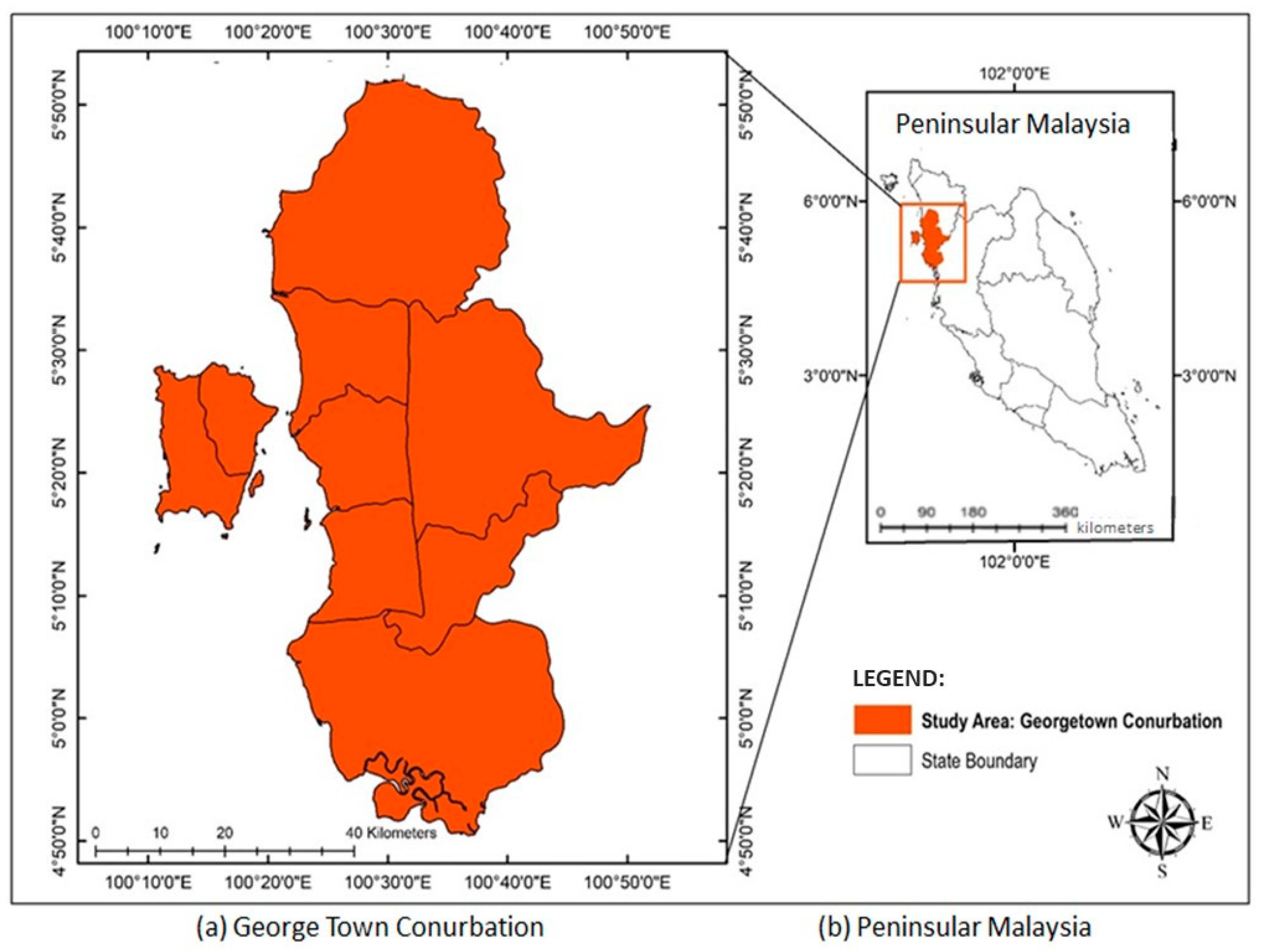
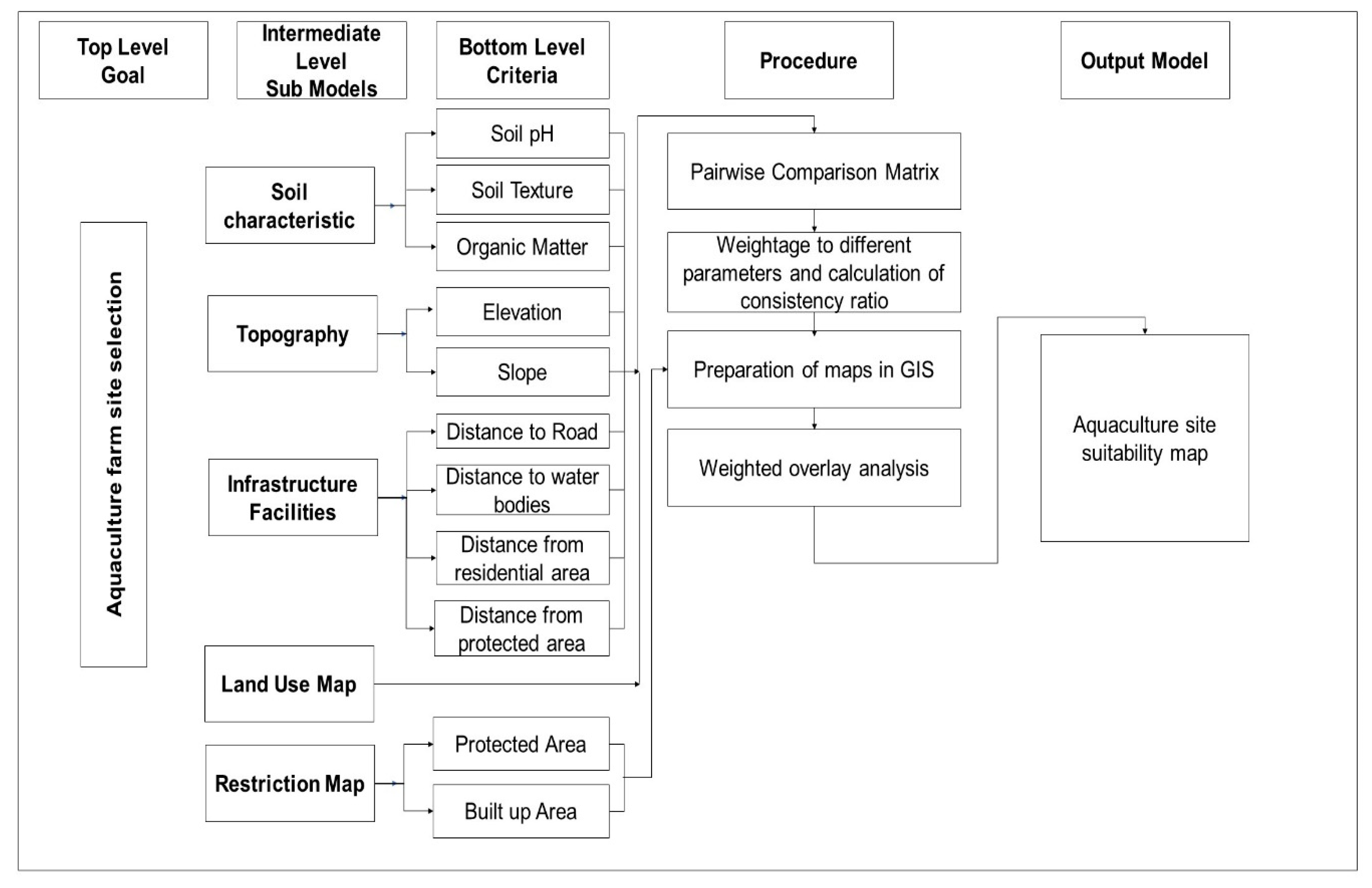

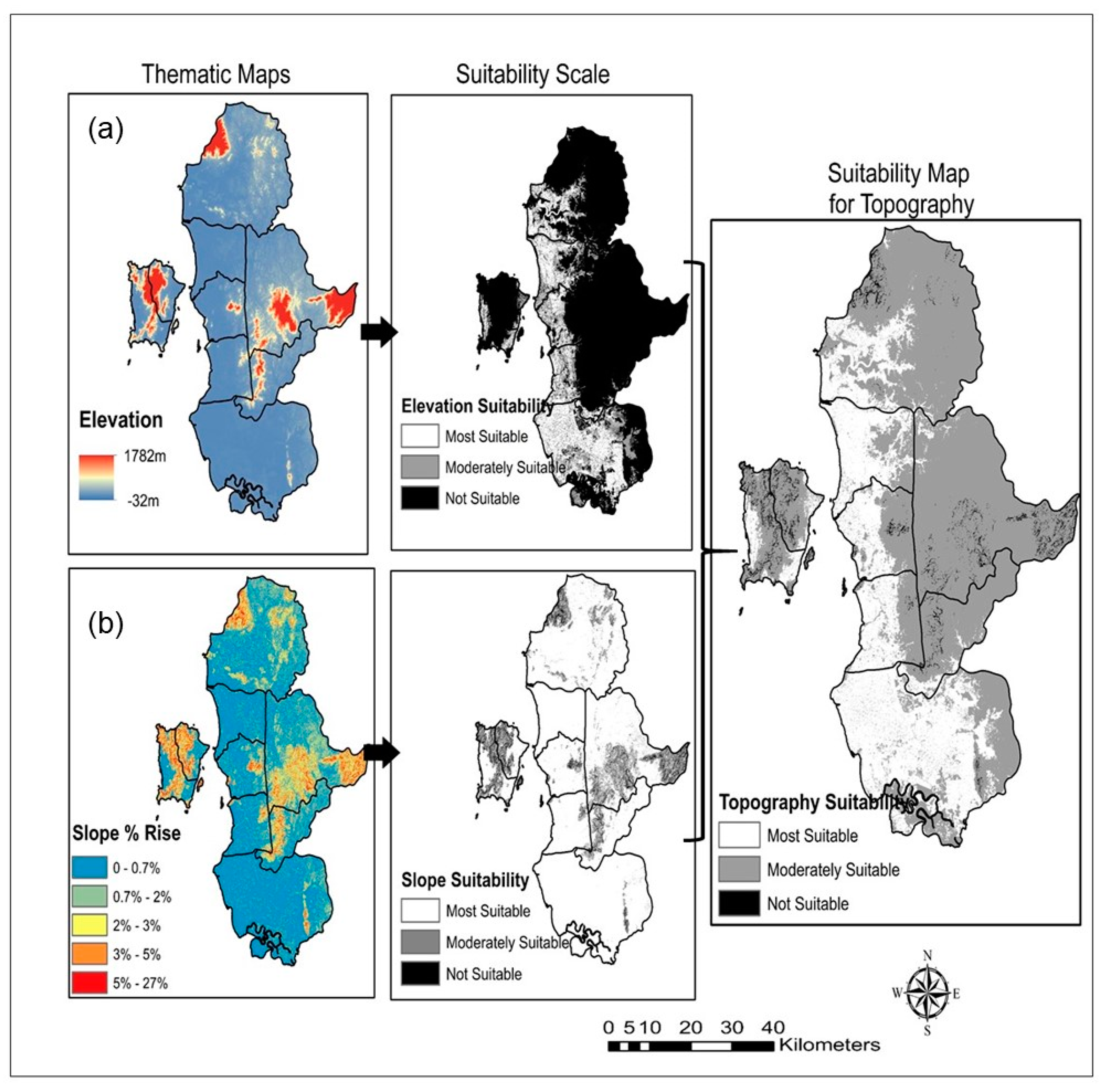
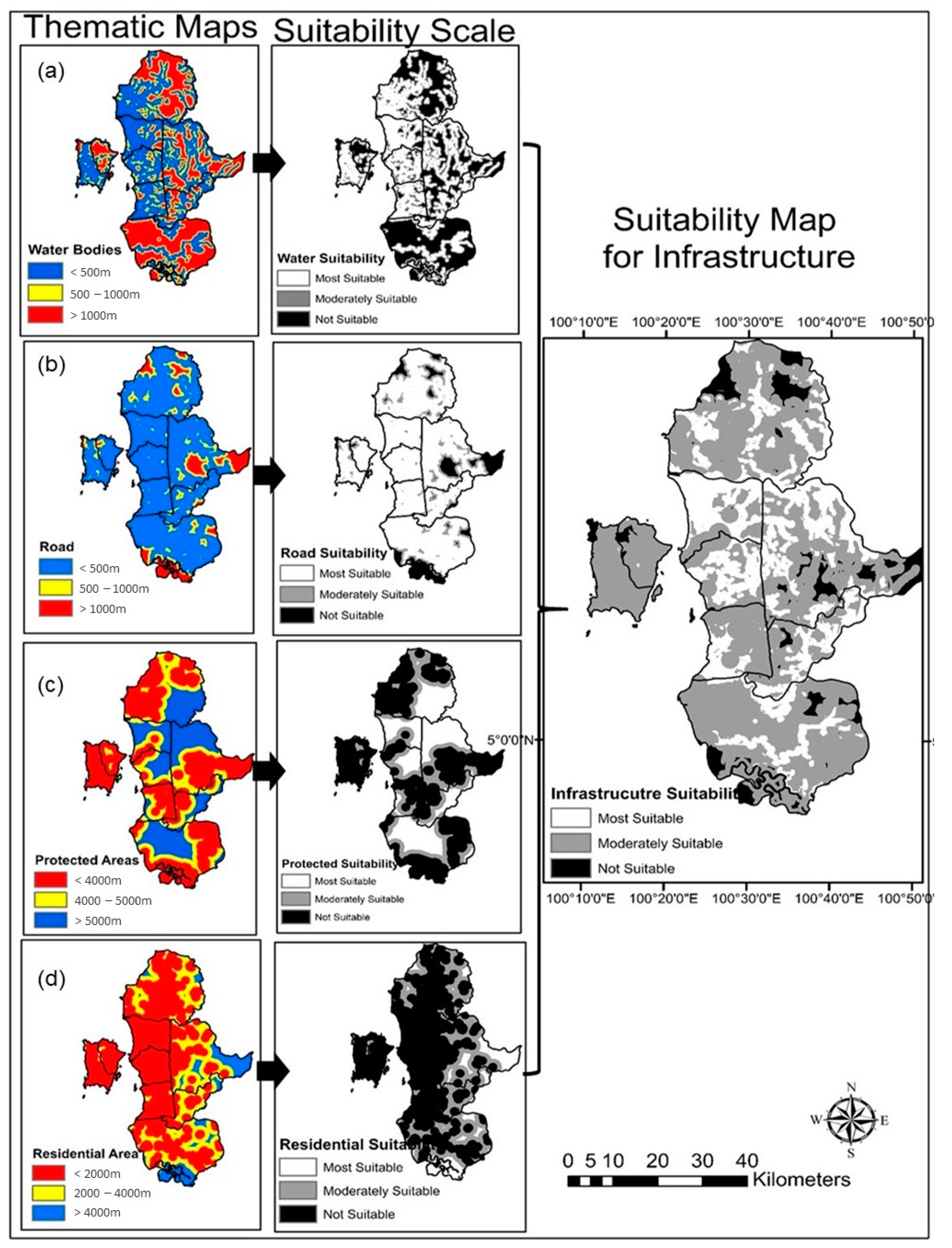
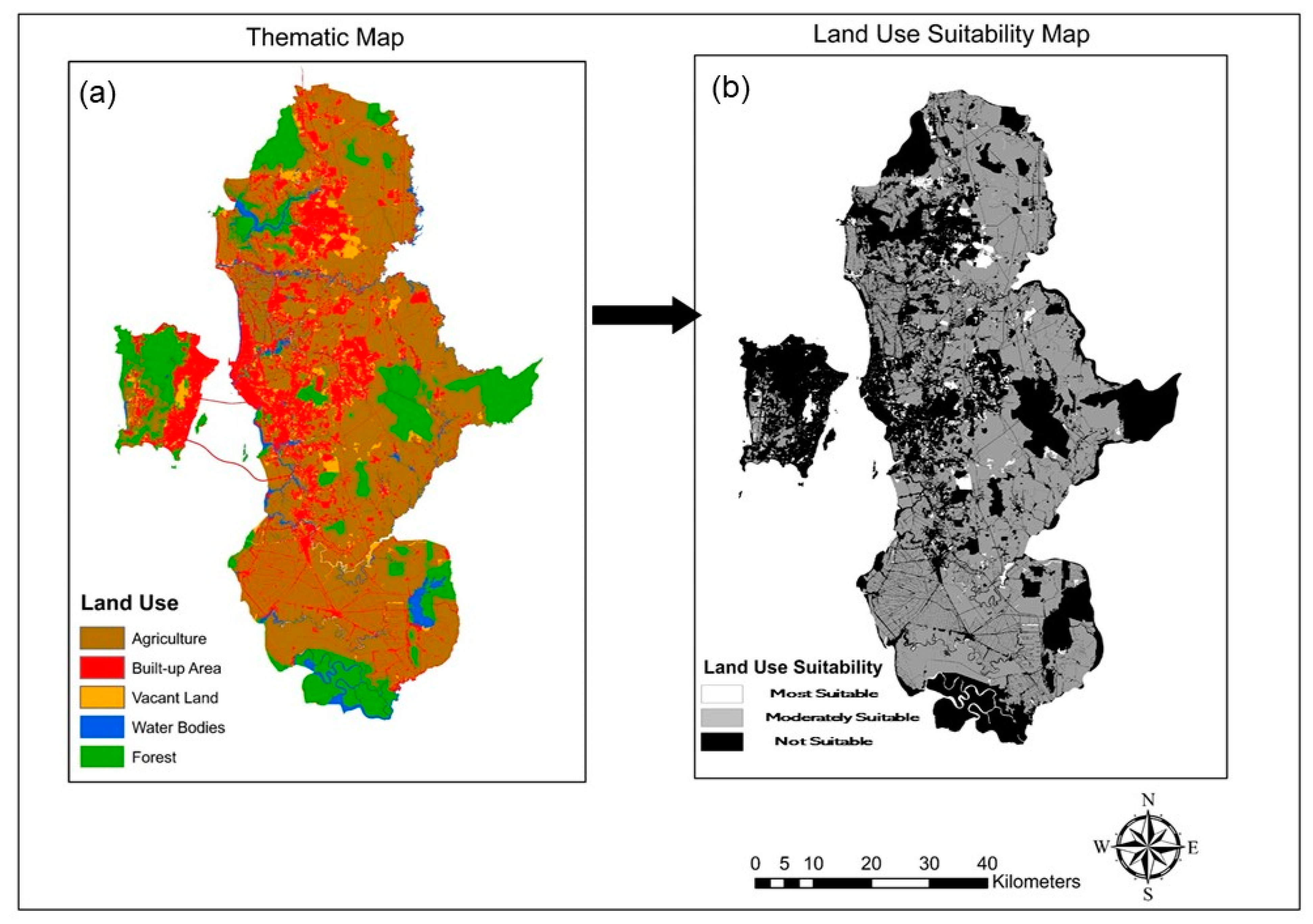
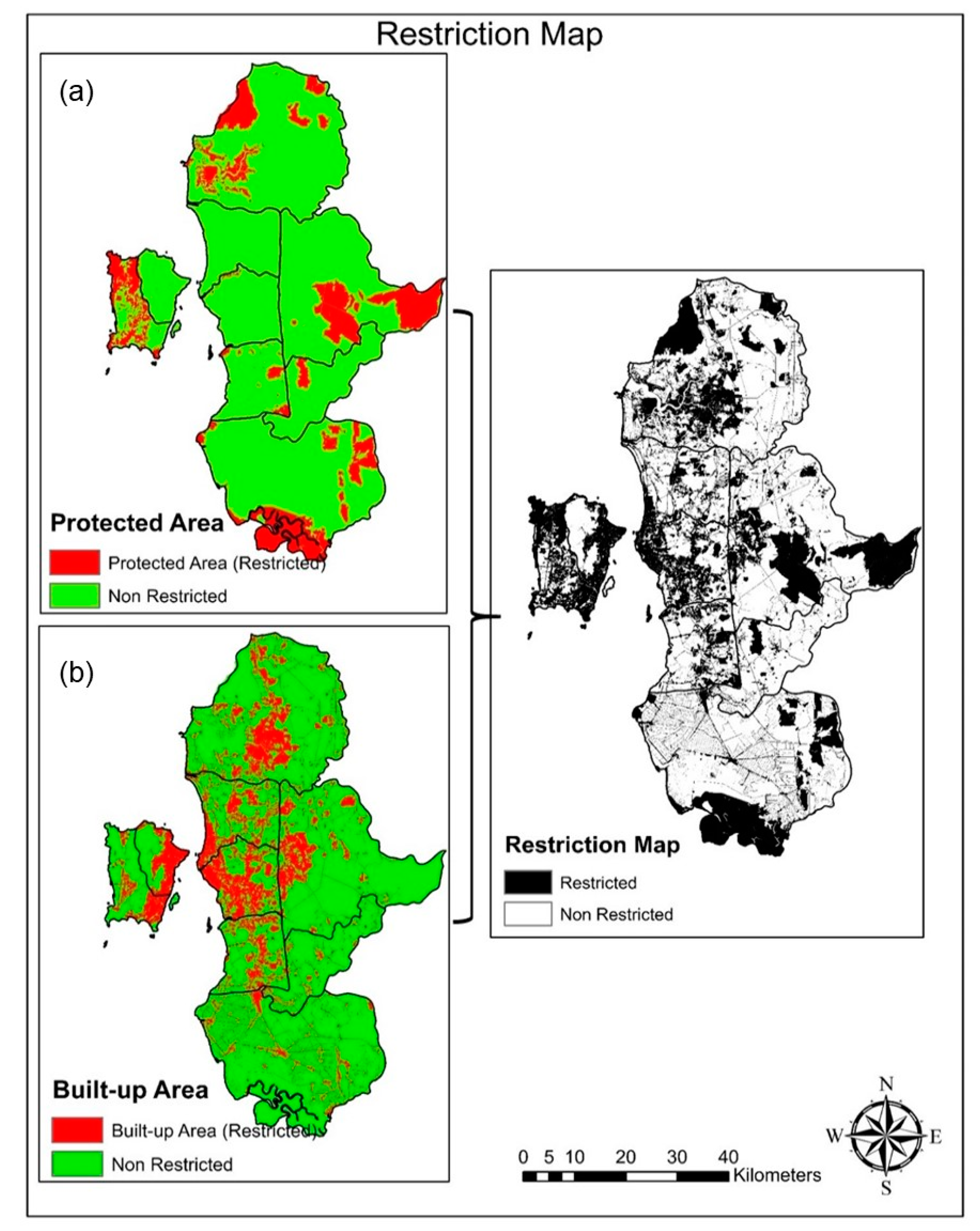
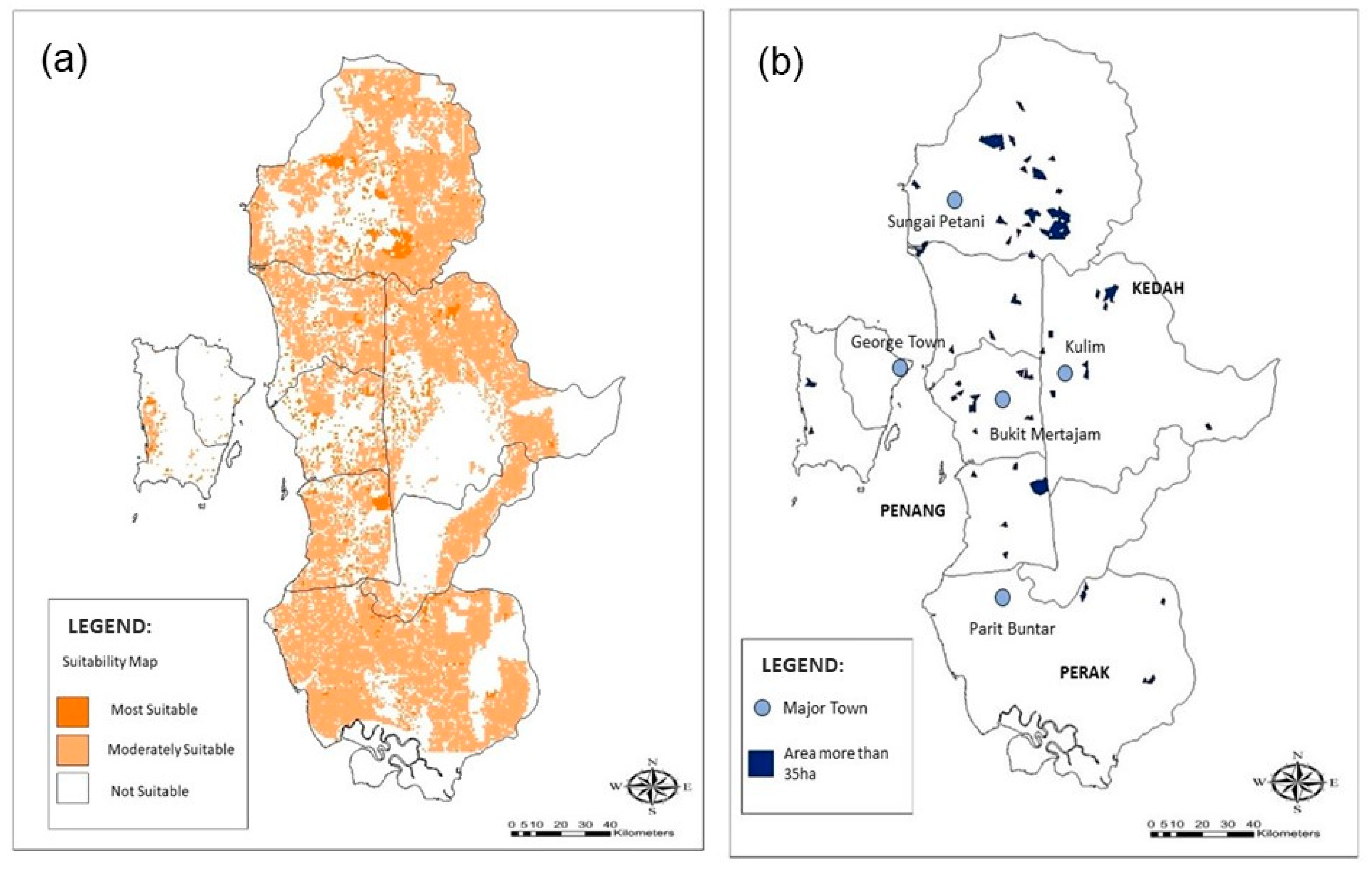
| Related Studies on Site Selection Task | Method Used | Types of Aquaculture | Criteria Included |
|---|---|---|---|
| [22] | GIS-based quantitative land evaluation method | Inland | Slope, land use type, soil thickness, soil pH, elevation requirements, suitability of soil type, soil texture, distance to sea or/and other water sources, population density, road distance, local markets, and incubators. |
| [20,23] | GIS-based multi-criteria evaluation (MCE) method | Marine | Sea temperature, chlorophyll, suspended sediment, bathymetry, distance to town, pier, and land-based facilities. Constraint layers consist of the harbour, area near town/industrial, and river mouth. |
| [24] | GIS-based multi-criteria evaluation (MCE) | Marine | Ammoniacal nitrogen, water depth, water pH, DO, salinity, water movement, soil type, turbidity, and plankton. |
| [25] | GIS-based multi-criteria evaluation (MCE) | Marine | Distance from fishery port, distance from river mouths, avoidance of shipping zone, and buffer zone of the special protection area. |
| [26] | GIS-based multi-criteria evaluation (MCE) method | Inland | Soil (pH, texture, organic matter), water quality (temperature, pH, DO, CO2, phosphate, nitrate, hardness, total alkalinity, transparency), infrastructure (distance to water source, road, market, hatchery) |
| [27] | GIS-based multi-criteria evaluation (MCE) method | Marine | Vegetation density, geology, geomorphology, soil (texture, pH, clay percentage, organic matter, sand percentage, EC, fertility, depth), infrastructure (distance to the sea, water outlet channel, residential areas) land use, height, slope, direction, distance to, distance to roads, distance to the industrial areas, distance to the aquaculture farms. |
| [28] | Flexible Voroni cell-based GIS model | Marine | Sea surface temperature, chlorophyll-α, turbidity, and salinity |
| [29] | GIS-based multi-criteria evaluation (MCE) method | Inland | Environmental (slope, land use, clay content of soil, pH soil, distance to rivers), economic (distance to roads, markets and inputs), Social (distance to populations, protected areas), and Physicochemical (pH, DO, temperature, alkalinity, and hardness) |
| [30] | GIS-based DANP (combination of decision-making trial and evaluation laboratory method (DEEMATEL) and analytical network process (ANP)) | Inland | Soil quality, water quality infrastructural and land use, soil pH, soil texture, soil organic matter, water temperature, water pH, water DO, phosphate, nitrate, hardness, water TDS, geology, distance from the fault, elevation, slope, aspect, land cover, distance from the protected area, distance from water resources, distance from the residential area, distance from roads, distance from the market. |
| Criteria | Suitability Rating and Score | |||
|---|---|---|---|---|
| 3 (Most Suitable) | 2 (Moderately Suitable) | 1 (Not Suitable) | Description | |
| Soil Characteristic | Fishpond requires low salinity and natural pH with low water infiltration | |||
| Soil pH | 6.5–8.5 | 5.5–6.5 and 8.5–9.0 | <5.5 and >9.0 | |
| Soil texture (texture) | Clay loam | Sandy clay | Loam, sand | |
| OM (% of carbon) | <1 | 1–2 | >2 | |
| Soil Condition | ||||
| Elevation (m) | 0–5 | 5–10 | >10 | The moderate slope is the most suitable for aquaculture pond |
| Slope (%) | 0–2 | 2–5 | >5 | |
| Infrastructural facilities | ||||
| Distance to water (m) | <500 | 500–1000 | >1000 | |
| Distance to road (m) | <500 | 500–1000 | >1000 | Proximity to existing infrastructure provides easy access to the aquaculture sites |
| Distance from protected area (m) | >5000 | 4000–5000 | <4000 | |
| Distance from residential area (m) | >4000 | 2000–4000 | <2000 | Aquaculture should not be too close to residential and protected areas to avoid environmental problems such as odour |
| Land Use | ||||
| Land Use | Vacant land | Agriculture | Built-up area, forest, water bodies | Vacant land is less expensive |
| 1/9 | 1/8 | 1/7 | 1/6 | 1/5 | 1/4 | 1/3 | 1/2 | 1 | 2 | 3 | 4 | 5 | 6 | 7 | 8 | 9 | |
|---|---|---|---|---|---|---|---|---|---|---|---|---|---|---|---|---|---|
| Extremely | Very Strongly | Strongly | Moderately | Equally | Moderately | Strongly | Very Strongly | Extremely | |||||||||
| Less Important | More Important | ||||||||||||||||
| Criteria | Soil pH | Soil Texture | Soil Organic Matter | Weight | ||
|---|---|---|---|---|---|---|
| Soil quality | ||||||
| Soil pH | 1 | 0.3 | ||||
| Soil texture | 1/2 | 1 | 0.2 | |||
| Soil organic matter | 3 | 2 | 1 | 0.5 | ||
| Consistency ratio | 0.031 | |||||
| Soil Condition | ||||||
| Criteria | Elevation | Slope | Weight | |||
| Elevation | 1 | 0.3 | ||||
| Slope | 2 | 1 | 0.7 | |||
| Consistency ratio | 0.000 | |||||
| Infrastructure Facilities | ||||||
| Criteria | Distance to Water Source | Distance to the Road | Distance from Protected Area | Distance from Residential Area | Weight | |
| Distance to water source | 1 | 0.4 | ||||
| Distance to road | 1/2 | 1 | 0.3 | |||
| Distance from protected area | 2 | 2 | 1 | 0.2 | ||
| Distance from residential area | 1/5 | 1/5 | 1 | 1 | 0.1 | |
| Consistency Ratio | –0.220 | |||||
| Overall | ||||||
| Criteria | Soil Characteristic | Infrastructural Facilities | Land Use | Soil Condition | Weight | |
| Soil Characteristic | 1 | 0.2 | ||||
| Infrastructural facilities | 1/3 | 1 | 0.2 | |||
| Land Use | 3 | 4 | 1 | 0.4 | ||
| Soil Condition | 2 | 1/2 | 1/2 | 1 | 0.2 | |
| Consistency Ratio | –0.7407 | |||||
| n | 1 | 2 | 3 | 4 | 5 | 6 | 7 | 8 | 9 | 10 |
|---|---|---|---|---|---|---|---|---|---|---|
| RI | 0 | 0 | 0.58 | 0.90 | 1.12 | 1.24 | 1.32 | 1.41 | 1.45 | 1.49 |
Publisher’s Note: MDPI stays neutral with regard to jurisdictional claims in published maps and institutional affiliations. |
© 2021 by the authors. Licensee MDPI, Basel, Switzerland. This article is an open access article distributed under the terms and conditions of the Creative Commons Attribution (CC BY) license (https://creativecommons.org/licenses/by/4.0/).
Share and Cite
Bandira, P.N.A.; Mahamud, M.A.; Samat, N.; Tan, M.L.; Chan, N.W. GIS-Based Multi-Criteria Evaluation for Potential Inland Aquaculture Site Selection in the George Town Conurbation, Malaysia. Land 2021, 10, 1174. https://doi.org/10.3390/land10111174
Bandira PNA, Mahamud MA, Samat N, Tan ML, Chan NW. GIS-Based Multi-Criteria Evaluation for Potential Inland Aquaculture Site Selection in the George Town Conurbation, Malaysia. Land. 2021; 10(11):1174. https://doi.org/10.3390/land10111174
Chicago/Turabian StyleBandira, Puteri Nur Atiqah, Mohd Amirul Mahamud, Narimah Samat, Mou Leong Tan, and Ngai Weng Chan. 2021. "GIS-Based Multi-Criteria Evaluation for Potential Inland Aquaculture Site Selection in the George Town Conurbation, Malaysia" Land 10, no. 11: 1174. https://doi.org/10.3390/land10111174
APA StyleBandira, P. N. A., Mahamud, M. A., Samat, N., Tan, M. L., & Chan, N. W. (2021). GIS-Based Multi-Criteria Evaluation for Potential Inland Aquaculture Site Selection in the George Town Conurbation, Malaysia. Land, 10(11), 1174. https://doi.org/10.3390/land10111174








